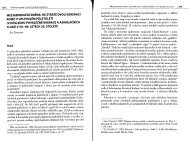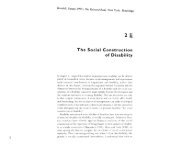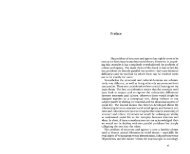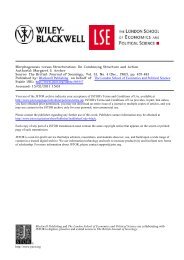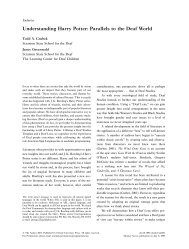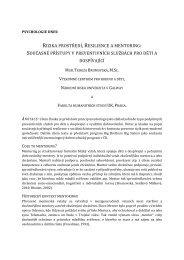Culture and Practical Reason Two Paradigms of ... - Moodle
Culture and Practical Reason Two Paradigms of ... - Moodle
Culture and Practical Reason Two Paradigms of ... - Moodle
- No tags were found...
Create successful ePaper yourself
Turn your PDF publications into a flip-book with our unique Google optimized e-Paper software.
Chapter <strong>Two</strong> 96 CUlture <strong>and</strong> <strong>Practical</strong> <strong>Reason</strong><strong>Two</strong> <strong>Paradigms</strong> <strong>of</strong> Anthropological Theory97And more, this conclusion from "experience" that culture does not existis an illusion doubly compounded. For it takes as the model <strong>of</strong> all sociallife not the reality <strong>of</strong> bourgeois society but the self-conception <strong>of</strong> thatsociety. It credits the appearance <strong>of</strong> Western culture as its truth, thusconspiring in the illusion that it really is the socialized product <strong>of</strong> practicalactivity by ignoring the symbolic constitution <strong>of</strong> the practical activity.Social science elevates to a statement <strong>of</strong> theoretical principle whatbourgeois society puts out as an operative ideology. <strong>Culture</strong> is thenthreatened with a neglect in anthropology that is matched only by theconsciousness <strong>of</strong> it in society.It is some consolation that in the line <strong>of</strong> praxis theory initiated by JulianSteward this neglect has become the source <strong>of</strong> a certain regret.Julian StewardSteward's founding perspective on "cultural ecology" is in general termsthe same as Morgan's decultured problematic, <strong>and</strong> in the details <strong>of</strong> theparadigmatic article on patrilineal b<strong>and</strong>s (1936) it is exactly Murdock'sidea <strong>of</strong> social structure. Thus it would not be worthwhile to make anexposition here were it not for the paradoxical context in which Steward,<strong>and</strong> later Murphy (1970), places his cultural ecology-as an opposition tothe biological. The paradox is instructive. Its unraveling will show how themystification <strong>of</strong> the cultural logic as the a priori <strong>of</strong> economic action establishesthe practical logic as the determinant <strong>of</strong> cultural form.In preamble to the main ecological argument on "primitive b<strong>and</strong>s,"Steward in one way or another allows himself the main technical <strong>and</strong> socialconditions <strong>of</strong> hunters <strong>and</strong> gatherers-referring some <strong>of</strong> these to economicadvantage, others to human nature, <strong>and</strong> still others simply to empiricalfact. Territorial "ownership" is underst<strong>and</strong>able on the basis that "anyanimal may secure food <strong>and</strong> water more efficiently in terrain which ithabitually utilizes"; family groups, on the basis <strong>of</strong> "a chronic sex excitability"in the human species; <strong>and</strong> the b<strong>and</strong> <strong>of</strong>families, on the grounds that"In practically all human groups several families cooperate.... This providesa kind <strong>of</strong> subsistence insurance" (Steward 1936, p. 332). The principalrelations <strong>of</strong> production-the division <strong>of</strong> labor by sex-are assumed byvirtue <strong>of</strong> their empirical generality among hunters. So also is the simpletechnology given, not only as a set <strong>of</strong> tools in themselves but as a selfevidentset <strong>of</strong> intentions, the provision <strong>of</strong> "subsistence." This technologyis deployed in areas <strong>of</strong> limited food resources; hence, hunters are able toachieve only small b<strong>and</strong> aggregates, on the order <strong>of</strong>twenty to fifty persons,<strong>and</strong> have low population densities.Given these conditions, the argument proceeds to determine the ecologicalbasis <strong>of</strong> various b<strong>and</strong> forms, "patrilineal," "matrilineal," <strong>and</strong> "composite."As in Murdock's analysis, the critical link between environment<strong>and</strong> social structure is residential practice. Steward concentrates on themost widespread b<strong>and</strong> type, the patrilineal, which he underst<strong>and</strong>s as theformalization <strong>of</strong> patrilocal residence. In the first version <strong>of</strong> the study(1936), patrilocality is explained by innate male dominance <strong>and</strong> theeconomic importance <strong>of</strong> men in hunting cultures (p. 333). In a later version,patrilocality is referred particularly to its economic advantages inareas <strong>of</strong> dispersed but fixed animal resources: "an environment in whichthe principal food is game that is nonmigratory <strong>and</strong> scattered, which makesit advantageous for men to remain in the general territory <strong>of</strong> their birth"(i.e., since they already know the territory) (1955, p. 135). With patrilocalitythus established on the grounds <strong>of</strong> its economic advantage, the structure<strong>of</strong> the b<strong>and</strong> follows as recognition <strong>and</strong> articulation-in a way by nowfamiliar to us. Patrilocal residence must aggregate "patrilineal" relatives.Therefore the incest tabu is imposed at the b<strong>and</strong> level, <strong>and</strong> the group isorganized as an exogamous patrilineage. To sum up the argument in generalterms: economic effectiveness in the given set <strong>of</strong> technical <strong>and</strong> environmentalcircumstances requires certain social practices <strong>and</strong> relations(patrilocal residence) which are in tum formulated <strong>and</strong> codified as a socialstructure (patrilineal b<strong>and</strong>). Pure Morgan. 3tThe proposition is also pure praxis. For it is specifically the "behaviorpatterns <strong>of</strong> work." as "required" by the ecological context, that arerealized in cultural form. Murphy explains Steward's perspective:The environment per se is not the critical factor, for the "behaviorpattems" required in its exploitation using certain "economic devices"are the key elements. These behavior patterns are work, <strong>and</strong> the"economic devices" technology. Quite simply, the theory <strong>of</strong> culturalecology is concerned with the process <strong>of</strong> work, its organization, itscycles <strong>and</strong> rhythms <strong>and</strong> its situational modalities [1970, p. 155].. . . Patterns <strong>of</strong>work are directly derivative from the tools <strong>and</strong>resources to which they are applied, <strong>and</strong> these two factors serve to31. The paradigm, praxis -+ practice -+ structure, is generalized by Steward in the fonn <strong>of</strong>"three fundamental procedures <strong>of</strong> cultural ecology": "First, the inter-relationship <strong>of</strong>exploitative or productive technology <strong>and</strong> environment must be analyzed .... Second,the behavior patterns involved in the exploitation <strong>of</strong> a particular area by means <strong>of</strong>a particular technology must be analyzed.... The third procedure is to acenain theextent to which the behavior patterns entailed in exploiting the environment affect otheraspects <strong>of</strong> culture" (1955, pp. 40-41).



